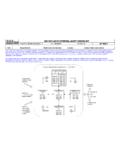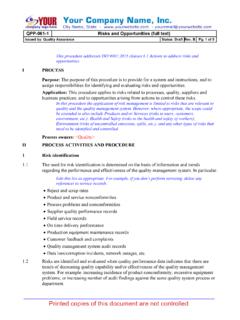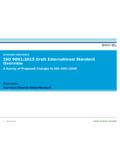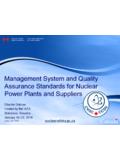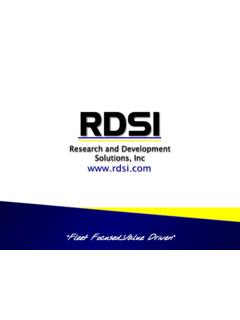Transcription of QM-06 Planning (full text) - IMSXpress ISO 9001 …
1 ACTIONS TO ADDRESS RISKS AND Risks are determined to prevent or reduce undesired effects, and to give assurance thatquality management system can achieve its intended Following types and categories of risks are determined and addressed:In iso 9001 does not define specific types of risks that need to be determined and determining the scope of risk management, remember that risk related requirementsreplace the requirements for preventive actions that were required in the previous editionsof the standard. The list below is probably the most minimalist scope acceptable: Processes: risks of nonconforming output, process breakdown, process inefficiency,excessive variability, etc. Quality: risk of defects and non attainment of specified requirements Suppliers: risk of defects and non attainment of specified requirements Business: risks to business continuity, data loss, public relations, etc.
2 ; Risk levels are evaluated using appropriate risk evaluation and analysis methods. When risklevels are high, appropriate risks reduction actions are implemented and integrated intoquality system processes. Risk reduction actions are proportionate to the potential impact onthe conformity of products and Processes related to determination and evaluation of risks, and to the implementation of riskreduction actions are defined in process proceduresQPP-061-1 Risks and Opportunities andQPP-061-2 Risk Reduction Actions and OpportunitiesThe concept of an 'Opportunity' is tied in iso 9001 :2015 to Risk, but the standard fails toadequately explain the relationship between the two. The only 'official' explanation is givenin a paper published by ISO titled 'Risk-based thinking in iso 9001 :2015'. In this paper, theopportunity is defined mostly as a 'positive effect of risk' -- a silver lining of having tomitigate or counteract risks.
3 It makes a good sense philosophically, but doesn't offer a cluehow to actually comply with the 'Opportunities' requirements in iso 9001 :2015. Shouldopportunities be identified independently and then analyzed for their own risks? Or, shouldrisk reduction measures be identified as opportunities? Or both? An opportunity is a set of circumstances which makes it possible to do positive things, forexample: Develop new products and services Develop new markets and/or increase market share Improve work environment Improve productivity QM-06 Planning (full text) Issued by: Quality assurance Status: Draft Rev. B Pg. 1 of 3 Improve operational efficiency (reduction of resource use, reduction of waste, etc.) Opportunities may be identified as positive effects of risks; as in a risk forcingimplementation of a risk reduction measure that is beneficial in a broader context than justreducing this particular risk.
4 For example, health risks may require measures to improveworking environment. However, these measure also create opportunities to attract betterqualified employees, improve morale and job satisfaction, and reduce turnover; and so thehealth risk creates opportunities to improve the overall job Taking or not taking an opportunity presents different levels of risk. To evaluate these risks,taking (or not taking) the opportunity is defined as a risk management project, and theassociated risks are evaluated as for any other project, , following process procedureQPP-061-1 Risks and QUALITY OBJECTIVES AND Planning TO ACHIEVE THEMIn iso 9001 quality Planning is addressed in several clauses. This section responds toClauses and , and thus addresses only Planning of the overall quality system andfor achieving quality objectives. Requirements for Planning of processes for provision ofproducts and services (manufacturing) are included in Clause Quality Quality objectives are established throughout the organization to implement the qualitypolicy, to meet requirements for products and processes, and to improve quality system andquality Quality objectives are established at the management reviews of the quality for establishing, implementing and monitoring quality objectives are defined inprocess proceduresQPP-062-1 Quality Objectivesand QPP-093-1 Management Quality objectives define the direction and priorities for continual Planning for achieving quality Plans for achieving quality objectives include determination of methods, resources,responsibilities, completion due dates, and evaluation criteria.
5 The process for Planning andimplementing quality objectives is defined in process proceduresQPP-062-1 Planning OF CHANGESP lanning of quality management system changes is implemented through managementreviews, Changes to the quality management system are determined and planned within theframework of management reviews, as defined in process procedureQPP-093-1 Management Review. Planning of changes may be in response to changing circumstances,such as product, process, capacity, or other operational or organizational changes; or toimprove the effectiveness and efficiency of the quality management When Planning for changes, the management review considers the purpose and QM-06 Planning (full text) Rev. B Pg. 2 of 3 consequences of the change, and its impact on the integrity of the quality managementsystem; as well as availability of resources and allocation responsibilities and Actions to implement changes may be defined in Management Review Actions (reviewoutput actions), actions to implement Quality Objectives, Corrective Actions (CAPAs), andRisk Reduction Actions.
6 QM-06 Planning (full text) Rev. B Pg. 3 of 3
